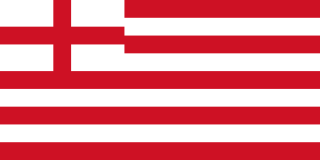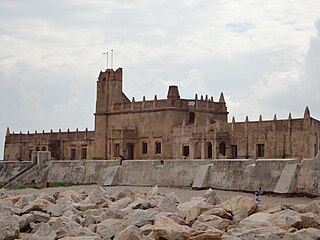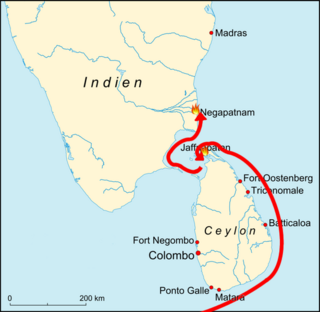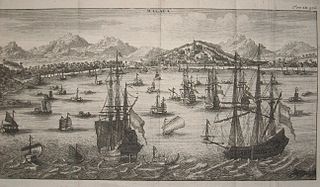
The Danish East India Company refers to two separate Danish-Norwegian chartered companies. The first company operated between 1616 and 1650. The second company existed between 1670 and 1729, however, in 1730 it was re-founded as the Asiatic Company.

Danish India was the name given to the colonies of Denmark in the Indian subcontinent, forming part of the Danish overseas colonies. Denmark–Norway held colonial possessions in India for more than 200 years, including the town of Tharangambadi in present-day Tamil Nadu state, Serampore in present-day West Bengal, and the Nicobar Islands, currently part of India's union territory of the Andaman and Nicobar Islands. The Danish and Norwegian presence in India was of little significance to the major European powers as they presented neither a military nor a mercantile threat. Dano-Norwegian ventures in India, as elsewhere, were typically undercapitalized and never able to dominate or monopolize trade routes in the same way that British, French, and Portuguese ventures could.

Bantam Presidency was a presidency established by the British East India Company and based at the Company factory at Bantam in Java. Founded in 1617, the Presidency exercised its authority over all the Company factories in India, including the agencies of Madras, Masulipatnam and Surat. The factors at Bantam were instrumental in founding the colony of Madraspatnam in 1639 with the Fort St. George, which later grew into the modern city of Madras. The Presidency of Bantam was twice downgraded, first in 1630 before being restored in 1634 and for the second time in 1653, when owing to the hostility of Dutch traders, the Presidency was shifted to Madras.

HDMS Fridericus Quartus, launched at Royal Danish Naval Dockyards in 1699, was a three-deck, 110-gun ship of the line designed to be the flagship of the Royal Dano-Norwegian Navy. She soon proved difficult to navigate, and unsuited for the shallow Danish waters. She was later used as an East Indiaman, first by the Danish East India Company and then by the Danish Asiatic Company. She was wrecked at Skagen in November 1736, shortly after embarking on her second DAC expedition to Tranquebar. She co-existed with another ship by the same name, a slave ship owned by the Danish West India Company, which wrecked off Costa Rica's coast in 1710.

The Dano-Mughal War, formally Danish East India Company's War against the Mughal Empire, was a colonial and maritime conflict between the Mughal Empire and the Danish East India Company over trade commerce in the Bay of Bengal. Lasting from 1642 to 1698, the conflict has also been referred to by historians as the Dano-Bengali Thirty Years' War

The Skirmish at Pipli or more formally the Destruction of the Danish factory at Pipli, was one of the two recorded land confrontations between the Danish East India Company and the Mughal Empire during the Dano-Mughal War. The Skirmish was a Mughal punitive expidition in retalition for the Danish arrest of a Persian merchant. The Skirmish ended in a Mughal victory, and the Danish factory in Pipli was destroyed and burned down.

The Danish rescue mission to Pipli refers to a rescue mission by the Danish East India Company to rescue, then recently, imprisoned Danes from Mughal imprisonment at the trading station of Pipely. The mission was successful and the six imprisoned Danes were freed. The mission can also be referred to as the Mission to pipli.
The Dano-Mughal Treaty was a peace treaty between the Mughal Empire and Denmark–Norway ending the 56-year-long Dano-Mughal War.

The Siege of Dansborg or the Siege of Fort Dansborg, was a short siege lasting from 20 to 30 December 1644, between general Tiagepule of Thanjavur and the Danish command at Fort Dansborg. The conflict started over the Danish rejection of the general's demand to tax Tranquebar, and as a result, a series of confrontations followed. The confrontations had no major result, and an armistice may have been signed.

The Siege of Dansborg alternatively the Siege of Fort Dansborg sometimes also referred to as Willem Leyel's siege of Dansborg, was a siege initiated by traveler and seafarer, Willem Leyel, against the men loyal to governor Bernt Pessart. The siege was concluded after the men at Dansborg opened the gates for Willem Leyel, surrendered, and accepted Leyel as the new governor.

The Siege of Dansborg or the Siege of Fort Dansborg, was a siege of the newly finished Danish fort of Dansborg in Trangebar in 1624. The siege was initiated by the nayak of Thanjavur, Raghunatha, because of the Danish rejection of the demands from the nayak. The Siege, laid by general Calicut, was abandoned after the arrival of Danish reinforcements from sea. The event is mostly described by Icelander, Jón Ólafsson, in his work The Life of the Icelander Jón Ólafsson, Traveller to India.

Roland Crappé's raids on Portuguese colonies refers to a series of raids by Dutchman in Danish service, Roland Crappé, on Portuguese Ceylon and India. The raids were partially unsuccessful, in that Crappé's ship, Øresund, caught fire and sank.

The Skirmish at the Strait of Malacca was a skirmish between the claimed governor of Tranquebar, Bernt Pessart, and the local authorities of Dutch Malacca. The confrontation led to the imprisonment or death of all of Pessart's crew and the confiscation of the vessel, Dend gode Haab. Although Pessart and his crew would later be released and cooperate with the Dutch to spy on the Spanish in Manila.

The Sieges of Tranquebar or the War between Tranquebar and Thanjavur refers to the warfare between the Thanjavur Nayak kingdom and Danish Tranquebar between 1655 – 1669. The Thanjavurian sieges were repelled, mainly due to the new fortifications being built around Tranquebar, and a peace agreement was issued in 1669.

The Conflict between William Leyel and Bernt Pessart refers to the tensions and minor civil war between Willem Leyel and Bernt Pessart over the governorship of Tranquebar and the Danish East India Company. The conflict led to the escape of Bernt Pessart, and the command at Tranquebar accepted Willem Leyel as governor of Danish India.

The Capture of St. Michael or the Seizure of St. Michael, was a Danish seizure of a Bengali ship in the Bay of Bengal. The Danes captured the Bengali ship and the vessel was subsequently incorporated into the Danish Navy given the name St. Michael.

The Attack in Hooghly was a Danish attack on two Bengali ships during the Dano-Mughal War in 1671. The Danes succeeded in blowing up the Bengali ships, and violence continued off the coasts of Kalingapatnam and Balasore.

The Battle of Balasore was an engagement between Bengali and English ships against Danish ships at Balasore. When the English failed to persuade the Danes, the Bengalis started attacking the English vessel, yet the English were rescued by the Dutch.
Roland Crappé or Roelant Crappé was a Dutch colonial official serving the Dutch and Danish East India Company. He became director general of the Ceylonese department of the Danish East India Company in 1618 and became commander in chief and governor of Tranquebar upon his seventh arrival in the Indies in 1624. During his leadership, new factories and offices were established and Danish trade went exceptionally well. He died in 1644 only a few years after his homecoming to Denmark.
Bernt Pessart, Berndt Pessart or Berent Pessart was a Dutch overhoved and self-proclaimed President of Danish India from 1636 to 1643. In his earlier years, he would serve the Dutch East India Company in Bantam, and in September 1636 he would land in Danish Tranquebar on the St. Jacob. Here he would serve the Danish East India Company until his deposure in 1643, after which he again would serve the Dutch East India Company by espionage on the Spanish Philippines. He would die in June 1645 by an ambush of local natives near Manila.




















